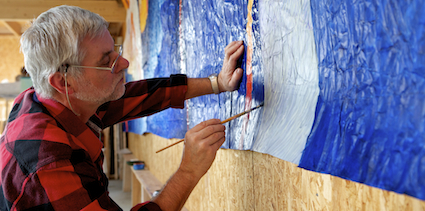
Biographical landmarks
1951 | Jean-Paul Ingrand’s birth in Mareuil in Charente (France)
1968 | Starts drawing and painting in a regular and steady way
1970 | Following a personal stay in Spain, he paints a set of landscapes whitened by the bright luminosity. Meets his future wife, Maria-Teresa Puertas, industrial designer
1972 | Joins the Ecole Nationale Supérieure of Applied Arts in Paris
1974 | Studies at the Ecole Normale Supérieure of Technical Studies in Cachan
1976 | Passes his CAPET (certificate for the teaching of technical studies) in drawing and applied arts with sculpture as an option
1978 | Passes his “agrégation” in plastic arts. He looks into the Goethean methodology of the understanding of natural phenomena
1979 | Year of research on pedagogical alternatives (Between others, the Waldorf pedagogy)
1981 | Is appointed to a position of applied arts in a technical secondary high school in Marseille
1982 | Tutor at the Ecole Normale d’Angoulême
1987 | Accidental death of his second son, Raphaël : he undergoes a psychological and spiritual reversal
1988 | Numerous creations using earth, stone and reinforced concrete. Has a sharp awareness of the metaphysical aspect of art
1989 | Begins a course in chromotherapy in accordance with the method of Doctor Hauschka-Stavenhagen. Follows steps of Kandinsky and Beuys in the approach of Steiner teaching in art, pedagogy and anthropology
1990 | Gives a cycle of lectures on art. Several seminars dealing with aestheticism and the role of culture
1995 | Accepts a public offer and achieves the realisation 1996 | of the large triptych of St.Paul’s church at Angoulême
1997 |Premature death of his wife : second reversal. Gets deeply involved in creating pictural work. Second commission of sacred art for the church of St.James at Cognac, but not completed
2001 | Junior lecturer in the history of art at the University 2002 | of Bordeaux III. Talence
2002 | Many exhibitions in Germany, principality of Andorra 2007 | and others galleries in Paris. Explores the structured actions of the multiple rays of light in space
2009 | Paper becomes a reserved material and is going to submit itself to numerous variations of reformatting, creasing, folding and dyeing. Exploiting such aspects of surface as light sensors
2011 | Chromatic search becomes involved in atmospheric variations and impressions of chiaroscuros
2012 | Pursuit of much research on paper. 2013 | Does achieve a setting for a choregraphy. Paints a series called “Variation on the cross”